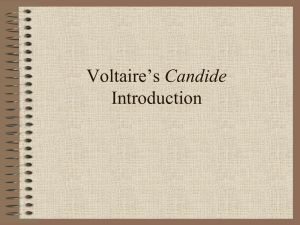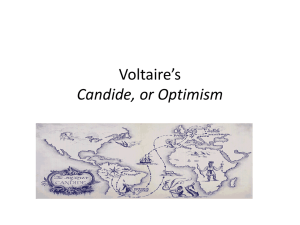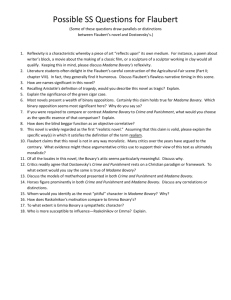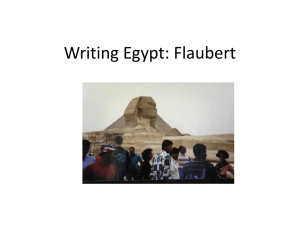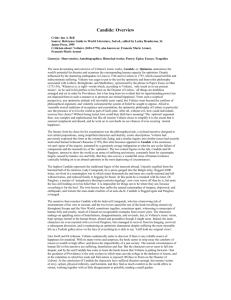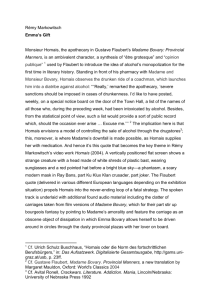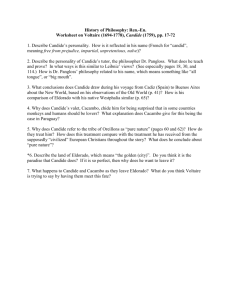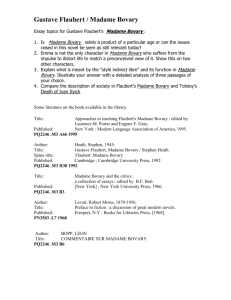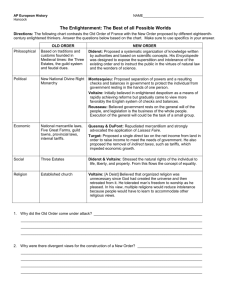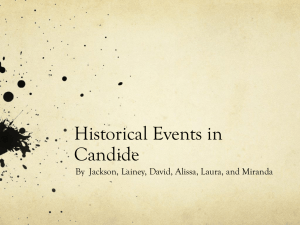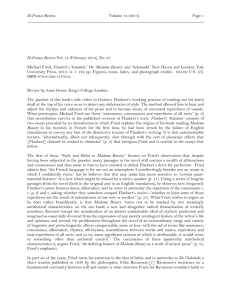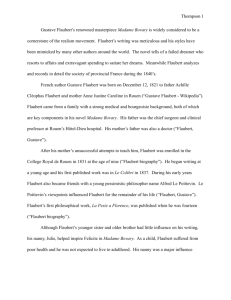Social Criticism in Candide & Madame Bovary
advertisement
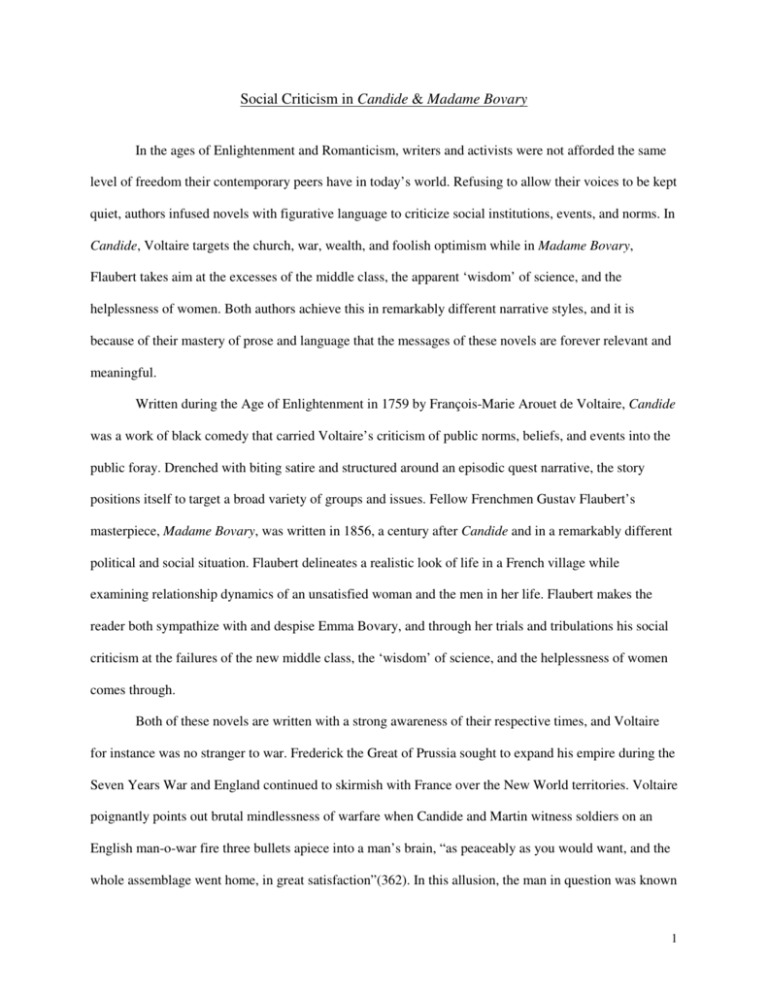
Social Criticism in Candide & Madame Bovary In the ages of Enlightenment and Romanticism, writers and activists were not afforded the same level of freedom their contemporary peers have in today’s world. Refusing to allow their voices to be kept quiet, authors infused novels with figurative language to criticize social institutions, events, and norms. In Candide, Voltaire targets the church, war, wealth, and foolish optimism while in Madame Bovary, Flaubert takes aim at the excesses of the middle class, the apparent ‘wisdom’ of science, and the helplessness of women. Both authors achieve this in remarkably different narrative styles, and it is because of their mastery of prose and language that the messages of these novels are forever relevant and meaningful. Written during the Age of Enlightenment in 1759 by François-Marie Arouet de Voltaire, Candide was a work of black comedy that carried Voltaire’s criticism of public norms, beliefs, and events into the public foray. Drenched with biting satire and structured around an episodic quest narrative, the story positions itself to target a broad variety of groups and issues. Fellow Frenchmen Gustav Flaubert’s masterpiece, Madame Bovary, was written in 1856, a century after Candide and in a remarkably different political and social situation. Flaubert delineates a realistic look of life in a French village while examining relationship dynamics of an unsatisfied woman and the men in her life. Flaubert makes the reader both sympathize with and despise Emma Bovary, and through her trials and tribulations his social criticism at the failures of the new middle class, the ‘wisdom’ of science, and the helplessness of women comes through. Both of these novels are written with a strong awareness of their respective times, and Voltaire for instance was no stranger to war. Frederick the Great of Prussia sought to expand his empire during the Seven Years War and England continued to skirmish with France over the New World territories. Voltaire poignantly points out brutal mindlessness of warfare when Candide and Martin witness soldiers on an English man-o-war fire three bullets apiece into a man’s brain, “as peaceably as you would want, and the whole assemblage went home, in great satisfaction”(362). In this allusion, the man in question was known 1 by readers as Lord Admiral Byng who was executed after a naval defeat. Voltaire also speaks of horrible brutishness by invading armies, where “old men, stunned from beatings, watched the last agonies of their butchered wives, who still clutched their infants to their bleeding breasts”(322). Allusions are made throughout the novel when referring to war scenes, tying them into actual occurrences. They also ground the tale into the contemporary world which adds richness and depth. Another major area of society that Voltaire attacks is religion and the Church, which is repeatedly mocked and ridiculed for its corruption and intolerance. When Cunégonde is taken, she is first the mistress of a Jew then is desired by the Grand Inquisitor of the church. Both enter into a bizarre dual ownership over the lady Cunégonde. The Old Woman who helps Candide and Cunégonde is in fact the daughter of a Pope, though popes are supposed to be celibate. The financial corruption of the church is also demonstrated with priests stealing gold and gems. These examples illustrate the ideals of the Enlightenment era, for which tolerance of different ideas was highly encouraged and the Church was criticized for its heavy insular and traditionalist view. The other critical element in Candide is the role of women in the story. Cunégonde plays the stereotypical ‘damsel-in-distress’, but loses her innocence through numerous rapes and abuse, ultimately becoming disfigured and ugly by the end. Paquette becomes a whore and squanders away money, and the Old Women is not even a proper name. Though Voltaire touched upon the place and stature of women, Flaubert expanded upon and developed the idea much further. Gustave Flaubert wrote in a very different time but ironically can be seen as wearing the same shoes as Voltaire. Both were challengers to the majority thought, and while Voltaire attacks the aristocratic high society, Flaubert laments at the mediocrity of the new bourgeois class arising in France. He demonstrates the gross materialistic nature of the bourgeois and its debilitating effect on families with the merchant Lheureux and Emma’s insatiable desire for fine goods, which ultimately results in the Bovary’s massive debt and loss of property. The fine clothes become a symbol of what high society represents and tempts Emma continuously. While Lheureux is more representative of the shrewd new businessmen, the pharmacist Homais is characterized as the true bourgeois in Flaubert’s eyes: motivated only by self-interest, seeking wealth, being politically aware and active, and ultimately win, regardless of 2 the situation. Flaubert shows that the power of the new bourgeois lies in the men, and they control the avenues to wealth and social standing. In the aristocratic society of Voltaire’s time, positions of power both in society and in wealth were also dominated by men and there was little chance for women to succeed in these areas. Flaubert uses the brooding nature of Emma to show failings of the Church. Depressed about the stagnant state of her marriage with Charles after staying in Yonville, Emma visits the nearby church to seek spiritual advice, but instead finds no help at all. The priest concerns himself with controlling rowdy children, complaining about his own life troubles and frustrations, and immediately assuming that Emma needs materialistic fulfillment such as firewood, bread, and brown sugar. Similar instances of clergyman being useless occur in Voltaire’s Candide as well. The literary tool of the motif with materialism is well crafted in this scene. Without the support and counsel of the church, Emma continues her downward spiral without recourse. Though the idealism of the Romantic age fueled the revolution in France, the Industrial Revolution had begun to mature and a new wave of belief in science and rationalism arose during Flaubert’s time. Critical of this belief, Flaubert mocks the bourgeois’s misplaced trust through the clubfoot operation of Hippolyte and Emma’s death. The apprentice Hippolyte was able to move around well, not perfect, but well despite having a clubfoot. In a move to gain power, Homais tempts Charles’ ego and prestige into attempting a new but high risk operation to cure it. The result of this small parable: the amputation of Hippolyte’s leg. Once again, Flaubert uses the repetition of the materialism motif to further emphasize the failings of society, this time in showing the victimization that comes from people desiring wealth and status at any cost. This desperate drive is also criticized in Candide through the squandering of Paquette and Giroflee as well the scheming Candide and Martin do to take back the riches of El Dorado. Unlike Voltaire, Flaubert makes the discussion concerning the role of women in society a central topic of his novel. His character, Emma, goes beyond merely demonstrating the expected docility and subordinate position women are intended to hold by having her fight against it. She is mentally and 3 physically active, and is continuously drawn to horse riding handsome figures such as Rodolphe rather than to boring men like Charles who have the personality of a cow. Flaubert uses these associative animals as effective symbols throughout the novel. Emma is indiscreet about her sexuality and freely has affairs. This is famously depicted in the carriage ride with Rodolphe, as Flaubert uses the carriage as a metaphor for their lovemaking within. Despite Emma’s actions though, she constantly comes across social obstacles that holds her back from attaining the status she desperately desires – a barrier faced by many women of that era. Similar in a sense to the ‘glass ceiling’ of the modern world, Flaubert uses the motif of a window to represent the helpless way Emma can only gaze upon her goals rather than being able to grasp them. Voltaire’s Candide and Flaubert’s Madame Bovary are both landmark stories that skillfully use figurative language and narrative to create a work of social criticism that raised conflict and questions in its time as well as ours. Though curiously finding the same sort of niche in their respective times, the authors were able to find similar criticisms about the materialism and wealth obsessed society and the corruption of religious institutions. They also focused on different topics such as the brutality of warfare with Voltaire and the true debate about women in society that Flaubert addresses. Ultimately however, the strength of these works is that they provide insightful and highly textured snapshots of their respective times but in two radically different ways, and there is clearly much to be learned from both. 4 Works Cited – Lawall, Sarah & Maynard Mack. The Norton Anthology of World Masterpieces, Volume II. 7th Ed. W.W. Norton & Company: New York © 1999. Candide translated by Robert M. Adams. Madame Bovary translated by Francis Steegmuller. 5
